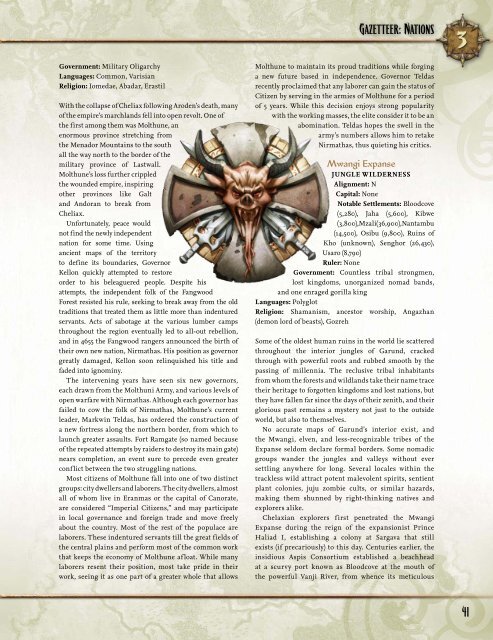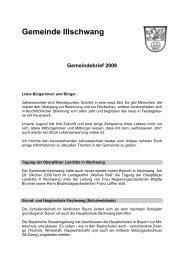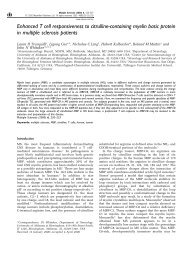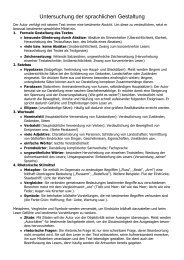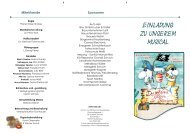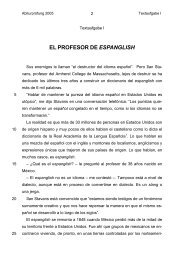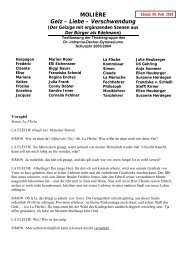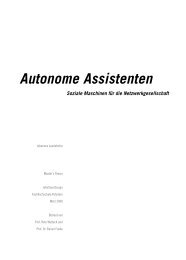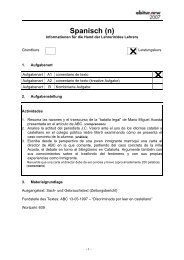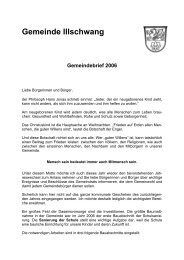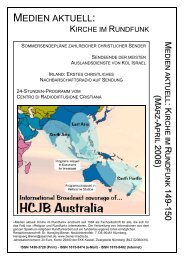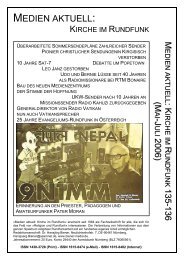Pathfinder Chronicles - Gazetteer - Asamnet
Pathfinder Chronicles - Gazetteer - Asamnet
Pathfinder Chronicles - Gazetteer - Asamnet
You also want an ePaper? Increase the reach of your titles
YUMPU automatically turns print PDFs into web optimized ePapers that Google loves.
Government: Military Oligarchy<br />
Languages: Common, Varisian<br />
Religion: Iomedae, Abadar, Erastil<br />
With the collapse of Cheliax following Aroden’s death, many<br />
of the empire’s marchlands fell into open revolt. One of<br />
the first among them was Molthune, an<br />
enormous province stretching from<br />
the Menador Mountains to the south<br />
all the way north to the border of the<br />
military province of Lastwall.<br />
Molthune’s loss further crippled<br />
the wounded empire, inspiring<br />
other provinces like Galt<br />
and Andoran to break from<br />
Cheliax.<br />
Unfortunately, peace would<br />
not find the newly independent<br />
nation for some time. Using<br />
ancient maps of the territory<br />
to define its boundaries, Governor<br />
Kellon quickly attempted to restore<br />
order to his beleaguered people. Despite his<br />
attempts, the independent folk of the Fangwood<br />
Forest resisted his rule, seeking to break away from the old<br />
traditions that treated them as little more than indentured<br />
servants. Acts of sabotage at the various lumber camps<br />
throughout the region eventually led to all-out rebellion,<br />
and in 4655 the Fangwood rangers announced the birth of<br />
their own new nation, Nirmathas. His position as governor<br />
greatly damaged, Kellon soon relinquished his title and<br />
faded into ignominy.<br />
The intervening years have seen six new governors,<br />
each drawn from the Molthuni Army, and various levels of<br />
open warfare with Nirmathas. Although each governor has<br />
failed to cow the folk of Nirmathas, Molthune’s current<br />
leader, Markwin Teldas, has ordered the construction of<br />
a new fortress along the northern border, from which to<br />
launch greater assaults. Fort Ramgate (so named because<br />
of the repeated attempts by raiders to destroy its main gate)<br />
nears completion, an event sure to precede even greater<br />
conf lict between the two struggling nations.<br />
Most citizens of Molthune fall into one of two distinct<br />
groups: city dwellers and laborers. The city dwellers, almost<br />
all of whom live in Eranmas or the capital of Canorate,<br />
are considered “Imperial Citizens,” and may participate<br />
in local governance and foreign trade and move freely<br />
about the country. Most of the rest of the populace are<br />
laborers. These indentured servants till the great fields of<br />
the central plains and perform most of the common work<br />
that keeps the economy of Molthune af loat. While many<br />
laborers resent their position, most take pride in their<br />
work, seeing it as one part of a greater whole that allows<br />
<strong>Gazetteer</strong>: Nations<br />
Molthune to maintain its proud traditions while forging<br />
a new future based in independence. Governor Teldas<br />
recently proclaimed that any laborer can gain the status of<br />
Citizen by serving in the armies of Molthune for a period<br />
of 5 years. While this decision enjoys strong popularity<br />
with the working masses, the elite consider it to be an<br />
abomination. Teldas hopes the swell in the<br />
army’s numbers allows him to retake<br />
Nirmathas, thus quieting his critics.<br />
Mwangi Expanse<br />
JUNGLE WILDERNESS<br />
Alignment: N<br />
Capital: None<br />
Notable Settlements: Bloodcove<br />
(5,280), Jaha (5,600), Kibwe<br />
( 3 , 8 0 0), M za l i ( 36,9 0 0), Nantambu<br />
(14,500), Osibu (9,800), Ruins of<br />
Kho (unknown), Senghor (26,430),<br />
Usaro (8,790)<br />
Ruler: None<br />
Government: Countless tribal strongmen,<br />
lost kingdoms, unorganized nomad bands,<br />
and one enraged gorilla king<br />
Languages: Polyglot<br />
Religion: Shamanism, ancestor worship, Angazhan<br />
(demon lord of beasts), Gozreh<br />
Some of the oldest human ruins in the world lie scattered<br />
throughout the interior jungles of Garund, cracked<br />
through with powerful roots and rubbed smooth by the<br />
passing of millennia. The reclusive tribal inhabitants<br />
from whom the forests and wildlands take their name trace<br />
their heritage to forgotten kingdoms and lost nations, but<br />
they have fallen far since the days of their zenith, and their<br />
glorious past remains a mystery not just to the outside<br />
world, but also to themselves.<br />
No accurate maps of Garund’s interior exist, and<br />
the Mwangi, elven, and less-recognizable tribes of the<br />
Expanse seldom declare formal borders. Some nomadic<br />
groups wander the jungles and valleys without ever<br />
settling anywhere for long. Several locales within the<br />
trackless wild attract potent malevolent spirits, sentient<br />
plant colonies, juju zombie cults, or similar hazards,<br />
making them shunned by right-thinking natives and<br />
explorers alike.<br />
Chelaxian explorers first penetrated the Mwangi<br />
Expanse during the reign of the expansionist Prince<br />
Haliad I, establishing a colony at Sargava that still<br />
exists (if precariously) to this day. Centuries earlier, the<br />
insidious Aspis Consortium established a beachhead<br />
at a scurvy port known as Bloodcove at the mouth of<br />
the powerful Vanji River, from whence its meticulous<br />
3<br />
41


